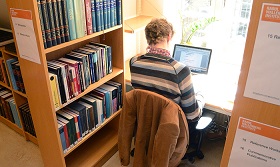We hear quite a bit these days about human rights and how we all need to work together to keep these rights intact. What are human rights? One definition is “everyone has the right to life, liberty and the security of person” (Article 3 of the Universal Declaration of Human Rights). Since the adoption of the UDHR in 1948, lawyers, victims, and advocates have been working to ensure the values enshrined in the document are upheld equally around the world. That’s when libraries can be the most helpful places to go to find materials to support this work.
Until this month, I didn’t know there were “human rights libraries.” In fact, they are everywhere in the world–many of them connected with universities or institutions, such as the University of Minnesota Human Rights Library, ASEAN Human Rights Library, the Netherlands Institute of Human Rights, or the Venice School of Human Rights! I exchanged emails with Karl Adam Tiderman, the sole librarian of the Raoul Wallenberg Institute of Human Rights in Lund, Sweden. Its library is the largest human rights library in Sweden, and it has an interlibrary lending system for all of the Nordic region. According to the website, their mission is “to facilitate research and to disseminate knowledge of human rights by providing access to up-to-date and relevant information and literature within the field of human rights and humanitarian law.” Tiderman wrote that the library works in “close cooperation with Lund University, the largest in Sweden” which allows them access to even more specialized areas. The library also belongs to the European Coordination Committee on Human Rights Documentation, which is “an open network of Europe-based organisations and institutions producing human rights information,” according to the ECCHRD site.

Karl Adam Tiderman
When asked about the most common topics researched today, Tiderman replied, “refugee questions are among the most common, but they have been so for several years. Topics that are more common now than before are migration, often related to Roma-people; so called ‘Human Rights cities;’ and human rights and the environment.”
How does one become employed in such a library? Tiderman has an MLIS but did not have any “special academic education in human rights.” He said they need generalists, but also look for staff interested in the field and who try “to be up to date with the current developments within the library sphere.” He’s learned most of his knowledge on the job, with the help of researchers. My own research has not turned up whether Tiderman’s educational experience is typical for a librarian in that field.

Raoul Wallenberg Library
Of course, you don’t have to go to Sweden to work in a human rights library. You can work practically anywhere in the world. Most of them appear to be connected with institutes or universities. The other interesting fact is that there are schools that focus their teachings on human rights. Besides the libraries listed above, here are a few more:
- The Center for Human Rights (part of Columbia University) in New York
- International Institute of Human Rights in Strasbourg, France (note: the page is written in French)
- Human Rights Institute of South Africa in Johannesburg
For more information on the literature available and the types of libraries, try Googling human rights libraries site:edu and you’ll see numerous relevant results. (You could also try that query instead using site:org). Another good source to check out is http://shell.cas.usf.edu/mccook/librariansandhumanrights.htm
Preserving human rights worldwide is essential to our well-being and knowing of the existence of these libraries and other centers of learning makes me feel hopeful that we can defend them.
All photos courtesy of Karl Adam Tiderman



0 Comments